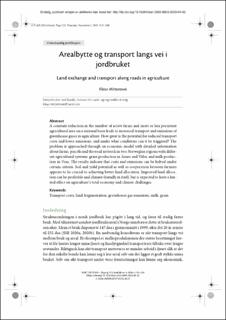| dc.contributor.author | Mittenzwei, Klaus | |
| dc.date.accessioned | 2021-04-06T17:53:18Z | |
| dc.date.available | 2021-04-06T17:53:18Z | |
| dc.date.created | 2021-01-13T09:07:30Z | |
| dc.date.issued | 2020-12-11 | |
| dc.identifier.citation | Kart og plan. 2020, 113 (4), 218-238. | en_US |
| dc.identifier.issn | 0047-3278 | |
| dc.identifier.uri | https://hdl.handle.net/11250/2736447 | |
| dc.description.abstract | A constant reduction in the number of active farms and more or less persistent agricultural area on a national basis leads to increased transport and emissions of greenhouse gases in agriculture. How great is the potential for reduced transport costs and lower emissions, and under what conditions can it be triggered? The problem is approached through an economic model with detailed information about farms, parcels and the road network in two Norwegian regions with different agricultural systems: grain production in Åsnes and Våler, and milk production in Voss. The results indicate that costs and emissions can be halved under certain criteria. Soil and yield potential as well as cooperation between farmers appears to be crucial to achieving better land allocation. Improved land allocation can be profitable and climate-friendly in itself, but is expected to have a limited effect on agriculture’s total economy and climate challenges. | en_US |
| dc.language.iso | nob | en_US |
| dc.publisher | Idunn | en_US |
| dc.title | Arealbytte og transport langs vei i jordbruket | en_US |
| dc.type | Peer reviewed | en_US |
| dc.type | Journal article | en_US |
| dc.description.version | acceptedVersion | en_US |
| dc.source.pagenumber | 218-238 | en_US |
| dc.source.volume | 113 | en_US |
| dc.source.journal | Kart og plan | en_US |
| dc.source.issue | 4 | en_US |
| dc.identifier.doi | 10.18261/issn.2535-6003-2020-04-02 | |
| dc.identifier.cristin | 1870321 | |
| dc.relation.project | Norges forskningsråd: 267710 | en_US |
| cristin.ispublished | true | |
| cristin.fulltext | postprint | |
| cristin.qualitycode | 1 | |
